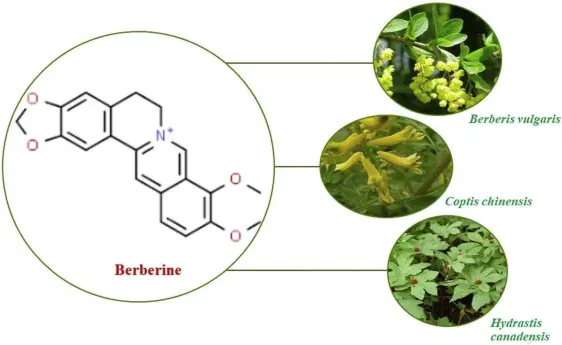Berberine: From Ancient Remedy to Modern Therapeutic Agent
Berberine (BBR), a natural alkaloid derived from plants such as Berberis aristata or Phellodendron amurense, has been an integral part of traditional Chinese medicine for centuries. Known as the active ingredient behind the bitterness of Huanglian, berberine is well-documented for its antibacterial, anti-inflammatory, and anti-ulcer properties. Recent scientific discoveries have unveiled its potential to address modern health challenges, including metabolic disorders, cardiovascular diseases, and even non-alcoholic steatohepatitis (NASH).
1. Antibacterial Properties
Berberine exhibits broad-spectrum antibacterial activity, effectively targeting gram-positive and gram-negative bacteria, fungi, and viruses. By reducing bacterial adhesion through suppression of fimbriae, berberine prevents infections and alleviates conditions like:
- Gastroenteritis
- Bacillary dysentery
- Suppurative otitis media
- Conjunctivitis
These properties make berberine an indispensable natural antimicrobial agent.
2. Anti-Inflammatory Effects
Berberine's anti-inflammatory potential was first recognized decades ago when it was found to reduce cholera toxin-induced inflammation in rats. Further studies demonstrated its ability to suppress the secretion of pro-inflammatory cytokines, such as IL-1, IL-6, and TNF. By modulating macrophage activity, berberine effectively mitigates inflammation, offering therapeutic benefits for a range of inflammatory conditions.
3. Beyond Traditional Uses: Modern Applications
Recent studies have expanded Berberine’s therapeutic potential into new areas:
3.1 Blood Sugar Regulation
Berberine is a powerful ally in managing type 2 diabetes. It improves insulin sensitivity, enhances beta-cell regeneration, and promotes insulin secretion under glucose stimulation. These mechanisms make it an effective agent for glycemic control, particularly for individuals with insulin resistance.
3.2 Lipid Management
Berberine helps lower blood lipid levels by activating AMP-activated protein kinase (AMPK), which upregulates genes responsible for lipid breakdown and downregulates genes involved in fat synthesis. This results in reduced triglyceride levels and a lower risk of atherosclerosis.
3.3 Cardiovascular Benefits
In addition to lipid management, Berberine supports cardiovascular health by improving endothelial function, inhibiting smooth muscle cell proliferation, and reducing macrophage inflammation. It also minimizes foam cell formation and platelet aggregation, making it a promising candidate for atherosclerosis prevention.
4. A Promising Future in NASH Treatment
Recent advancements have revealed Berberine’s potential in treating non-alcoholic steatohepatitis (NASH), a chronic liver disease linked to metabolic syndrome. By regulating lipid metabolism and improving insulin resistance, Berberine reduces fat deposition in the liver and mitigates inflammation.
The compound works through the liver SIRT1 pathway, enhancing autophagy and reducing lipid accumulation in hepatic cells. Additionally, the activation of the berberine-SIRT1-FGF21 axis could pave the way for obesity treatments by promoting brown fat formation and increasing energy expenditure. These findings indicate berberine’s potential as a novel therapeutic option for metabolic and liver-related disorders.
Conclusion
From its origins as a remedy for gastrointestinal infections to its modern applications in managing metabolic and cardiovascular diseases, Berberine has proven to be a versatile and powerful natural compound. Ongoing research continues to uncover new therapeutic possibilities, making berberine a promising agent for addressing contemporary health challenges.
While its expanded applications remain under investigation, berberine’s long history of safety and efficacy underscores its enduring value in both traditional and modern medicine.










